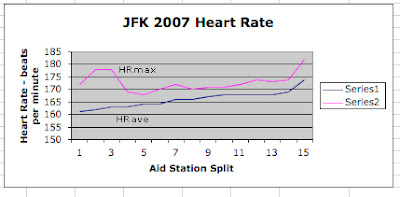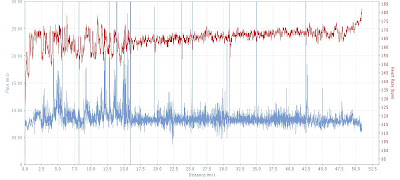Some have suggested that in running three 50 milers in 15 days I’ve stumbled upon a new training regimen. Others have suggested that I’m crazy. I think both of those statements are a little true, but, in retrospect, I prefer to think of it as a grand experiment. Regardless of how one wants to label the effort, I went from thinking I was undertrained and out of shape to running a 50 mile PR in 15 days.
While I had felt so unsure of myself heading into MMTR two weeks prior, I came to the JFK 50 starting line with the knowledge that I could handle 50 miles on my current training. My only concerns were (1) there would be a lot of running late in the race, (2) I’d die of boredom on the towpath, and (3) running two 50 milers in the previous two weeks would catch up to me. Only the first if these concerns was founded.
Trail Time (15.91 miles – 2:25:42 – 9:09 pace)
When the start of the 45th annual JFK 50 was sounded I once again took off at a conservative speed. During the early road mile I watched the leaders pull away. By the time we hit the longest climb on the course up to the Appalachian Trail I had lost sight of the leaders. Instead, I was surrounded by runners who sounded like they were exerting a bit too much effort for so early in the race.
On hitting the AT, I tried to keep my cool. Rather than fighting the rocky sections, I attempted a zen-like approach to navigating the rocks. I would let the trail tell me where to run rather than forcing the shortest route. During the AT stretch I generally maintained my place with folks slowly going by. Playing conservative, I walked a fair number of the hills. During my time on the AT, I got to catch up with some runners I’d met previously as well as meeting some new ones such as some Navy runners who I’d see more of later in the day. I exited onto the towpath at 2:25:42. My average heart rate (HRave) for these first 15.9 miles was 161 beats per minute (bpm).
The 26 mile hill (26.30 miles – 3:39:40 – 8:21 pace)
Over the past 5 years I’ve heard much about the JFK and the towpath section in particular. What no one had told me that we ran upstream the whole way! When I hit the towpath I looked over at the Potomac River and did a did a double take. Was it flowing towards where I was coming from? Yup. Up to that point I had always just assumed that the race was down the C&O Canal, not up it. My mistake. I’m not sure if the effect is purely psychological, but I felt the like I was running uphill for the entirety of the next 26+ miles. Whether or not this is true doesn’t matter, it was a bit disheartening when confronting the section of the course that already had me worried. It had been a long time since I’d run 26 straight miles.
Yet again, I settled into a conservative pace based on my heart rate. I wanted to stay in the low 160s and tried not to go over 162 or 163. This controlled effort let me spend some early towpath miles with Prasad Gerard, who I’ve known since before I started ultrarunning. I intended to run conservatively through mile 25, if not further. I ended up doing so until shortly after mile 30.
Somewhere between mile 10 and 13 mile of the towpath I started to very slow catch up Francesca Conte as well as some Navy boys. When I eventually caught the three Naval Academy students we settled into a nice rhythm. We started going a bit harder than I would have liked, but it was so much easier psychologically easy to run with the pack that I hung with them. After a few miles, all but one of the Navy boys, Matt Davis, fell off the pack at an aid station.
After settling back into my desired 165 bpm, Matt and I pushed on together. I had a great time chatting with this Marine-to-be. We came through the mile 30 aid station moving well together. (Hello, to the blog reader who said hi from the MCRRC Cafe at this aid station – leave a comment and introduce yourself.) A couple miles out of this aid station Joe Clapper of the VHTRC rode by on a bike and told Matt and I that we were in 48th and 49th place, which means we were likely in 50th place coming through the mile 30 aid station. At the next aid station, Matt stopped for aid and while I relaxed a bit following the aid station, he didn’t catch back up.
[In writing this a week after the fact, my memory might be off by an aid station for the previous two paragraphs. The occurrences described therein might have all take place a full aid station earlier.]
For the final 10 miles of the towpath I had very little company. The lone exception being James Cathro, a former Naval Academy student. While he was in run/walk mode due to his longest training run being 13 miles, we put in a good hard mile together with somewhere between 5 to 7 miles left on the towpath. While I didn’t enjoy the first half of the towpath very much, I enjoyed it more and more as the miles clicked off. Not only did each passing mile marker bring me closer to leaving the C&O behind, the towpath also grew more rustic. I hope to remember for a long time looking across the Potomac and seeing palisades with brilliant yellow-leaved trees along the river, brilliant white sycamores just above them, and the fiery oranges and reds of hardwoods filling the upper portions of the facing hill. Awesome.
Despite the monotony of the towpath marathon (actually 26.3 miles), I ran it well. Once an aid station break on a short section is factored out, I maintained an average pace of between 8:12 and 8:27 for each of the aid station splits on the tow path with a total average pace of 8:21. (8:12, 8:17, 8:26 – corrected, 8:19, 8:25, 8:27, 8:18:, 8:20)
The Road (8.45 miles – 1:08:13 – 8:04)
Once you get off the towpath you face a wonderful, glorious hill. For the first time in three hours and forty minutes I had a good reason to walk … and I did. After the hill, I set out to make up time. For the final miles of the towpath I have begun to think that my goal of running a 7:30 JFK was looking ok and that breaking my then 50 PR of 7:18 and change was a possibility. After each mile clicked by, I would calculate if I would break my PR if I ran 9:00 or 8:30 pace the rest of the way, and what kind of cushion I had on both my PR and 7:30 at various paces.
Early in this leg I frequently caught people, but only caught one person in the final 5 miles despite moving very well with 7:59, 8:09, and 7:37 average paces for the final three aid station splits. I ended up finish 25th in 7:13:45 (8:39 pace).
 A table of my race data including
A table of my race data includingsplit distances, times, pace, HRave, and HRmax
(Click on table for larger view)
Team Montrail
In a huge surprise, Team Montrail, of which I was the third and final scoring member, won the men’s team competition.
 Team Montrail after winning 2007 JFK 50 men’s team championship.
Team Montrail after winning 2007 JFK 50 men’s team championship.(from l-to-r, me, Sean Meissner, and Eric Grossman)
photo by Ed “Cappuccino” Cacciapaglia
Analysis
Though I hadn’t planned it ahead of time nor really even in the course of the stretch, running three 50 milers in 15 days gave me the opportunity to test how hard an effort I could maintain for 50 miles. At Mountain Masochist my HRave was 157 bpm, at Stone Cat it was 161, and at JFK it was 165. The 165 bpm effort was significantly higher than my previous 50k target effort of 160 bpm – though I would let that effort increase in the second half of 50ks. Even my my HRave of 162 bpm over the first 16 miles of JFK was higher than my previous 50k target effort. My previous 50 mile target effort was 155 bpm. For the first 45 miles of MMTR just two weeks earlier I had aimed for 155 bpm, hoped not to go above 160 bpm, and shut down to a walk whenever I hit 165 bpm. I guess this means that I can race much harder than I’ve been letting myself.
The series of races helped me to both consciously and unconsciously gradually increase my effort through out the race. This led to me maintaining or increasing my HRave from each of the 14 sections to the next. I began the race with 161, 162, and 163 section HRaves. At the end of the towpath and beginning of the road section, I averaged 168 bpm for each of four consecutive sections and nearly 12 miles before closing with HRaves of 169 and 174 for the final two sections.
 A comparison for my average and maximum heart rates
A comparison for my average and maximum heart ratesfor each aid station split of the 2007 JFK 50
Here are some other JFK race reports that I’ve enjoyed reading:
Greg Loomis
Greg Crowther [Broken link to blog post entitle “More Than I Can Chew” removed.]
Annette Bednowsky
My Late Fall Fun:
Mountain Masochist 50 mile race report (11/3)
Stone Cat 50 mile race report (11/10)
JFK 50 mile (11/17)
SNP thru-run – 107 miles (11/24-25) [Canceled – Greg Loomis and I decided to rest up for Hellgate instead]
Hellgate 100k (12/8)



